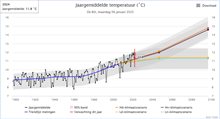Causes of increasing heat
According to the KNMI'23 climate scenarios, not only are average temperatures rising, but extreme heat events are also occurring more frequently. Heat is increasing worldwide because Earth is warming. Several human activities are enhancing the greenhouse effect. In addition, cities tend to experience higher temperatures than the surrounding areas, as cities retain more heat. This is referred to as the heat island effect. The increasing proportion of buildings and pavement in cities is adding to the heat island effect. The paragraphs below provide more details on these two effects.
What is enhancing the greenhouse effect?
The greenhouse gases in the atmosphere retain solar radiation and create a “natural” greenhouse effect. Without this effect, average temperatures on Earth would be 33 degrees lower. Various human activities, such as burning fossil fuels and deforestation, release more greenhouse gases into the atmosphere, among which CO2. This enhances the greenhouse effect and leads to global warming.
How sharply are temperatures rising?
Over the past 130 years, average worldwide temperatures have risen by more than 1.2 °C. The Netherlands has seen an even sharper rise: the KNMI climate dashboard shows that since 1901 average temperatures in our country have risen by 2.3 °C. This is also reflected in the image below. Half of the temperature rise in the Netherlands since the beginning of the last century took place in the last 30 years. According to the KNMI climate scenarios, average temperatures in the Netherlands will continue to rise in the years ahead. If you look at the climate dashboard, in the most extreme scenario, temperatures by around 2050 will have increased by another 1.6°C and by round 2100 by 4.4°C. The warming is greatest in summer and smallest in winter and spring.

How much does extreme heat increase?
Tropical nights will also increase during the summer, with minimum temperatures of 20°C or higher. In the extreme scenario, the number of tropical nights per summer in De Bilt increases from 0.3 in the current climate to 3 around 2050 and to 19 in 2100. There will also be more summer days, with a maximum temperature of 25°C or higher. In the extreme scenario, the number of summer days per year in De Bilt increases from 28 in the current climate to 49 around 2050 and 89 around 2100.
What is causing the heat island effect?
In cities, temperatures tend to rise higher than in nearby rural areas, as cities retain more heat. This heat island effect is enhanced by the increasing proportion of pavement in cities. The heat island effect is caused by the following factors:
- Stony materials absorb solar radiation and thus heat up.
- Urban environments lack evaporation as they feature little vegetation and water. Consequently, a large proportion of the solar radiation is converted into perceivable heat.
- Various human activities emit heat, e.g., in industrial facilities and in homes.
The difference in temperature between urban and rural environments is greatest at night, as after sunset, cities cool down at a slower pace. The temperature difference can rise to more than 7 degrees. The severity of an urban heat island effect mainly depends on the proportion of buildings, pavement, and surface greenery. Contributing factors are the building height – street width ratio, and how much heat buildings and other surfaces are releasing into the atmosphere. Another factor is whether the spacing of buildings permits wind flow. Ergo, the geometry of a street or neighbourhood affects the local temperature: some neighbourhoods are more conducive to a severe heat island effect than others. More details on the heat island effect in various types of neighbourhood are provided in the Book of examples: “The climate, just up your street”.
